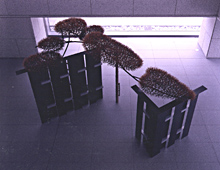6a
森村泰昌と関西ニューウェーブ
Yasumasa Morimura and Kansai New Wave
【本文確定】
1985年7月、京都のギャラリー16で開催されたグループ展「ラデカルな意志のスマイル」で、森村泰昌は奇妙な写真作品を発表しました。耳を切り落としたゴッホの自画像に自らが扮し、顔にもペイントをほどこすなどして撮影した、大型のセルフポートレートでした。ヨデンマモルは『美術手帖』誌の展評欄で、「形容しがたい奇妙なナマナマしさの感覚」と戸惑いました*6a1。その後森村泰昌は、アングルやマネの名画、デュシャンやニジンスキーのポートレート等に次々と成りすましました。1990年2月、東京の佐賀町エキジビット・スペースで開催された個展「美術史の娘」では、ベラスケスが描いたハプスブルク家の王女として、ゴヤによる美術史の娘マハとして、黄色人種男性である自らの肉体を曝しました。
日本の美術教育でまず接するのは西洋名画であって、日本の美術ではないのです*6a2。自画像から出発し、自身を美術史の娘であると規定した森村泰昌の軌跡からは、西洋の美意識をインストールされ西洋を愛してやまない日本人の「私」を自覚し、その「私」を客観視する強靱な批評精神が見てとれます。そして、それこそが1985年の時点でヨデンマモルを戸惑わせたものだったのではないでしょうか。1980年代前半に特有な、自由な感性で表現し、軽々と歴史から逃れ出ようとした傾向とは明らかに異質でした。かといって未視感とオリジナリティの重圧に立ち返るわけでもなく、盗用(アプロプリエーション)であると同時に自己同一性(アイデンティティ)の脱構築でもあるという、また別のポストモダニズム芸術の方向性が示されました*6a3。
1980年代前半は大阪や京都や神戸などの関西圏でもニューウェーブ的な絵画やレリーフ、インスタレーションが現れました。新表現主義ならではのストレートなその熱気は「関西ニューウェーブ」と呼ばれ、「バッド」な原色インスタレーションの中西學、「超少女」の松井智恵や杉山知子、写真や身体イメージを使用した石原友明、有機的オブジェの椿昇らが、兵庫県立近代美術館の「アート・ナウ」や滋賀県立近代美術館の「シガ・アニュアル」等のシリーズ展で紹介されました。そして森村泰昌のデビューを機に、1980年代後半の関西はいわゆるニューウェーブ風味からポップ風味へと転回したと考えてよいと思います*6a4。その勢いは東京や横浜などの関東圏を凌駕していたため、「西高東低」と言われました*6a5。藤本由紀夫がサウンド・オブジェを作り、中ハシ克シゲが日本的ポップ彫刻、今村源が軽量彫刻、中原浩大は17万個のレゴブロックを用いた彫刻のほか、果物、タニシ、電化製品、美少女フィギュアを利用するなど柔軟に発想しました。また、コンプレッソ・プラスティコやアイデアル・コピーがシミュレーショニズム的なアートユニットとして登場し、古橋悌二を中心とするダム・タイプは多ジャンルのアーティストからなるパフォーマンス集団として世界11カ国を巡回しました。1990年前後にはおたく少年ヤノベケンジやおたく少女西山美なコがデビューし、言葉のアートのイチハラヒロコは関西弁のまま東京で活動を開始しましたが後に故郷の京都に帰りました。
Morimura Yasumasa presented a strange photo work at a group exhibition, "Smile with Radical Will," which was held at Galerie 16 in July 1985. It was a photo of the large self-portrait of van Gogh, without his ear, in which Morimura himself played the role of the artist by adding paint to his own face as van Gogh's face. Yoden Mamoru expressed confused feeling in his critique on the photo work in the Bijutsu Techo, commenting that "an indescribably eccentric and vivid sensitivity."*6a1 Following after this exhibition, Morimura pretended to be the famous pictures of Ingre and Manet, portraits of Duchamp and Nizinskii, one after another. In February 1990, he exposed his body as an Asian male in doubling as the princess of Hapsburg painted by Velazquez at his one-man exhibition "Daughters in Art History" held at the Sagacho Exhibit Space of Tokyo.
In later years, Morimura said in his speech at the Japan Society in New York that the Japanese learn about famous Western art first in their art education, not about the art of Japan*6a2. As Morimura started his way of art with self-portrait proclaiming himself "a daughter of art history," we can see his strong critical mind to look at "himself" objectively as a Japanese installed with a western sense of beauty and urged to love the West. That could be the thing that made Yoden confused by Morimura's work at the exhibition in 1985. It was obviously different in quality from the first part of the 1980s scene in which the artists were expressing freely their sensibility to attempt an easy escape from the history. It did not mean that he went back to face the heavy pressure of jamais vu and originality, rather it showed the direction for another postmodernist art which is appropriation and, at the same time, deconstruction of identity*6a3.
In the first part of the 1980s, the new wave type of painting, relief and installation appeared in Osaka, Kyoto and Kobe in the Kansai area as well. The dynamic heat of the phenomena, because of its characteristics of the Neo-Expressionism, was called "Kansai New Wave." In this movement, many artists were introduced in a series of art exhibitions such as the "Art Now" at the Hyogo Contemporary Art Museum and the "Shiga Annual" at the Shiga Modern Art Museum. They were Nakanishi Manabu, a creator of "bad" primary color installations, Matsui Chie and Sugiyama Tomoko of "Supergirls," Ishihara Tomoaki, who applied photographs and body images, and Tsubaki Noboru, who used organic objects. In the late 1980s, Morimura's debut triggered the beginning of change from the so-called new wave flavor to the pop flavor*6a4. Because this trend had a much more powerful influence in Kansai than those in Kanto, around Tokyo and Yokohama, it was regarded as "Seikou Toutei" i.e. "High in Kansai, Low in Kanto*6a5." Fujimoto Yukio started making sound objects and Nakahashi Katsushige worked on Japanese pop sculptures. Imamura Hajime produced light weight sculptures and Nakahara Kodai, with his flexible ideas, made a sculpture using 170 thousand Lego blocks and used many materials such as fruits, mud snails, electrical appliances and pretty girl figures for his objects. During this period, Complesso Plastico and Ideal Copy came onto the scene as an art unit of Simulationism. Dumb Type, led by Furuhashi Teiji, formed a group of artists from various genre to perform their art works in the world. They visited eleven countries. Around 1990, Yanobe Kenji, an Otaku boy, and Nishiyama Minako, an Otaku girl, made debuts and, around this time, Ichihara Hiroko started her activities as a laguage artist in Tokyo with her Kansai dialect, but later she returned to her hometown, Kyoto.


